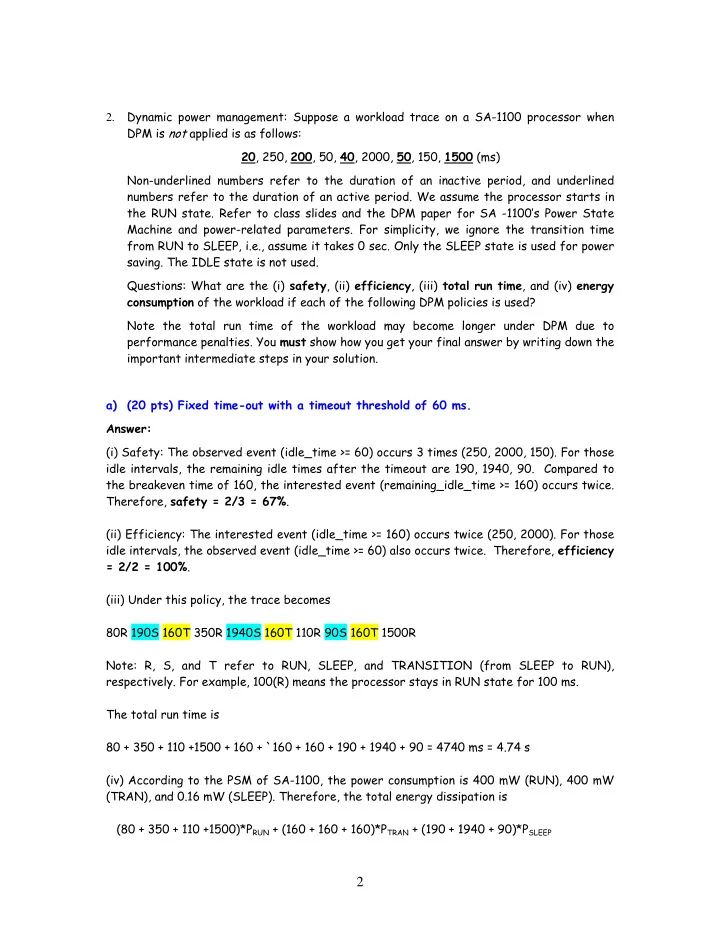

2. Dynamic power management: Suppose a workload trace on a SA-1100 processor when DPM is not applied is as follows: 20 , 250, 200 , 50, 40 , 2000, 50 , 150, 1500 (ms) Non-underlined numbers refer to the duration of an inactive period, and underlined numbers refer to the duration of an active period. We assume the processor starts in the RUN state. Refer to class slides and the DPM paper for SA -1100’s Power State Machine and power-related parameters. For simplicity, we ignore the transition time from RUN to SLEEP, i.e., assume it takes 0 sec. Only the SLEEP state is used for power saving. The IDLE state is not used. Questions: What are the (i) safety , (ii) efficiency , (iii) total run time , and (iv) energy consumption of the workload if each of the following DPM policies is used? Note the total run time of the workload may become longer under DPM due to performance penalties. You must show how you get your final answer by writing down the important intermediate steps in your solution. a) (20 pts) Fixed time-out with a timeout threshold of 60 ms. Answer: (i) Safety: The observed event (idle_time >= 60) occurs 3 times (250, 2000, 150). For those idle intervals, the remaining idle times after the timeout are 190, 1940, 90. Compared to the breakeven time of 160, the interested event (remaining_idle_time >= 160) occurs twice. Therefore, safety = 2/3 = 67% . (ii) Efficiency: The interested event (idle_time >= 160) occurs twice (250, 2000). For those idle intervals, the observed event (idle_time >= 60) also occurs twice. Therefore, efficiency = 2/2 = 100% . (iii) Under this policy, the trace becomes 80R 190S 160T 350R 1940S 160T 110R 90S 160T 1500R Note: R, S, and T refer to RUN, SLEEP, and TRANSITION (from SLEEP to RUN), respectively. For example, 100(R) means the processor stays in RUN state for 100 ms. The total run time is 80 + 350 + 110 +1500 + 160 + `160 + 160 + 190 + 1940 + 90 = 4740 ms = 4.74 s (iv) According to the PSM of SA-1100, the power consumption is 400 mW (RUN), 400 mW (TRAN), and 0.16 mW (SLEEP). Therefore, the total energy dissipation is (80 + 350 + 110 +1500)*P RUN + (160 + 160 + 160)*P TRAN + (190 + 1940 + 90)*P SLEEP 2
= 2040*400 + 480*400 + 2220*0.16 = 1008355.2 (microJ) = 1.0083552 (J) b) (20 pts) Fixed time-out with a timeout threshold of 600 ms. Answer: (i) Safety: The observed event (idle_time >= 600) occurs once (2000). For that idle interval, the remaining idle time after the timeout is 1400. Compared to the breakeven time of 160, the interested event also occurs. Therefore, safety = 1/1 = 100% . (ii) Efficiency: The interested event (idle_time >= 160) occurs twice (250, 2000). For those idle intervals, the observed event (idle_time >= 600) occurs once. Therefore, efficiency = 1/2 = 50% . (iii) Under this policy, the trace becomes 1160R 1400S 160T 1700R. The total run time is 4420 ms = 4.42 s. (iv) The total energy dissipation is (1160 + 1700)*P RUN + 160*P TRAN + 1400*P SLEEP = 2860*400 + 160*400 + 1400*0.16 = 1208224 (microJ) = 1.208224 (J) c) (20 pts) Threshold-based predictive shutdown with a threshold of 60 ms? (i) Safety: The observed event ( active _time <= 60) occurs 3 times (20, 40, 50). The idle times after those active intervals are 250, 2000, 150. Compared to the breakeven time of 160, the interested event occurs twice. Therefore, safety = 2/3 = 67% . (ii) Efficiency: The interested event (idle_time >= 160) occurs 3 times (250, 2000). The active intervals before those idle intervals are 20 and 40. Therefore, efficiency = 2/2 = 100% . (iii) Under this policy, the trace becomes 20R 250S 160T 290R 2000S 160T 50R 150S 160T 1500R The total run time is = 1860 + 480 + 2400 = 4740 ms = 4.74 s (iv) The total energy dissipation is (20 + 290 + 50 + 1500)*P RUN + (160 + 160 + 160)*P TRAN + (250 + 2000 + 150)*P SLEEP = 1860*400 + 480*400 + 2400*0.16 3
= 936384 (microJ) = 0.936384 (J) d) (10 pts) If the workload is performance critical (but less energy constrained), which policy should we use? What if the workload is energy constrained (but less performance critical)? The analysis should be based on the above quantitative analysis. Answer: If the workload is performance critical, we should use fixed timeout with a threshold of 600 ms as it introduces the least performance penalty. If the workload is energy constrained, we should use predictive shutdown with a threshold of 60 ms as it has the lowest energy consumption. 4
Recommend
More recommend